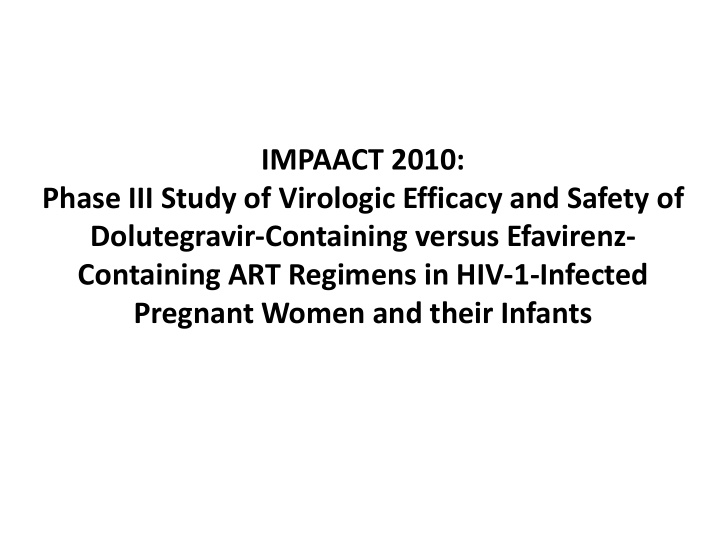



IMPAACT 2010: Phase III Study of Virologic Efficacy and Safety of Dolutegravir-Containing versus Efavirenz- Containing ART Regimens in HIV-1-Infected Pregnant Women and their Infants
Study 2010 Design n=183 Arm 1: Maternal DTG/FTC/TAF During Pregnancy and Postpartum Maternal follow-up Maternal and infant follow-up for 50 weeks after delivery for approximately 12-26 weeks (infant receives local standard prophylaxis) prior to delivery Arm 2: Maternal DTG/FTC/TDF During Pregnancy and Postpartum n=183 R Maternal follow-up Maternal and infant follow-up for 50 weeks after delivery for approximately 12-26 weeks (infant receives local standard prophylaxis) prior to delivery Arm 3: Maternal EFV/(FTC or 3TC)/TDF During Pregnancy and Postpartum Maternal follow-up n=183 Maternal and infant follow-up for 50 weeks after delivery for approximately 12-26 weeks (infant receives local standard prophylaxis) prior to delivery Enrollment at Completion of follow-up 14-28 weeks gestation Delivery at 50 weeks postpartum 12-26 weeks 6 14 26 38 50 Weeks on Study
Study 2010 Design • Randomised 1:1:1 open label 3-arm trial (183/arm, 549 total) – DTG/TAF/FTC vs. – DTG/TDF/FTC vs. – EFV/TDF/XTC • Women starting ART at 14-28 weeks gestation (and their children), followed through 50 weeks postpartum (prior ARVs for PMTCT permitted) • Multinational (23 IMPAACT sites, 2 in US)
Study 2010 Endpoints • Primary endpoints: – Virologic efficacy (< 200 cp/mL at delivery) – Adverse pregnancy outcomes (spontaneous abortion, fetal death, SGA, or preterm delivery) – Maternal and infant toxicity • Main secondary endpoints: – Virologic suppression • At 50 weeks postpartum • To <50cp/mL at delivery • By FDA snapshot algorithm – Bone (by DXA) and renal toxicity (mothers and infants) – Mother-infant ARV transfer at birth and from breast milk – MTCT, ARV drug resistance (in HIV+ infants, mothers with VF) – Adherence – Postpartum depression • Anticipate starting in first half of 2017 at 23 sites (most in Africa; few in Thailand, Brazil, India, possibly US)
Adherence Support • Will outline and strongly encourage minimal package of adherence support (in MOP) – Education and adherence planning at initiation – Basic support and check-in package – Intensified approach, if virologic failure • Training/support for site staff • Wish to foster minimal standards, without mandating approach that is unlikely to be offered to non-trial population
Assessment of Adherence • Virologic suppression – HIV-1 RNA at entry, then at 4, 8, 12 and 24 weeks on ART; delivery; then at weeks 14, 26, 38 and 50 postpartum • Self-report (not used in adherence support) – 3-item scale (Wilson et al) at each study visit • Hair ARV levels at delivery (mother) / birth (infant) – Monica Gandhi et al • Survey at final (50-week postpartum) visit to assess barriers to/facilitators of adherence
Discussion • Many thanks to Rivet Amico and members of the AWG who have provided input thus far – Rivet has joined the protocol team – Additional input welcome • Possible separate capsule to perform qualitative work around adherence (? IDIs, FGDs in participants, study staff)
Recommend
More recommend